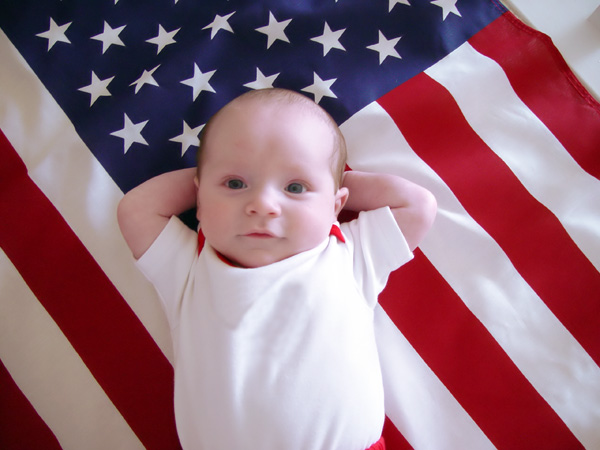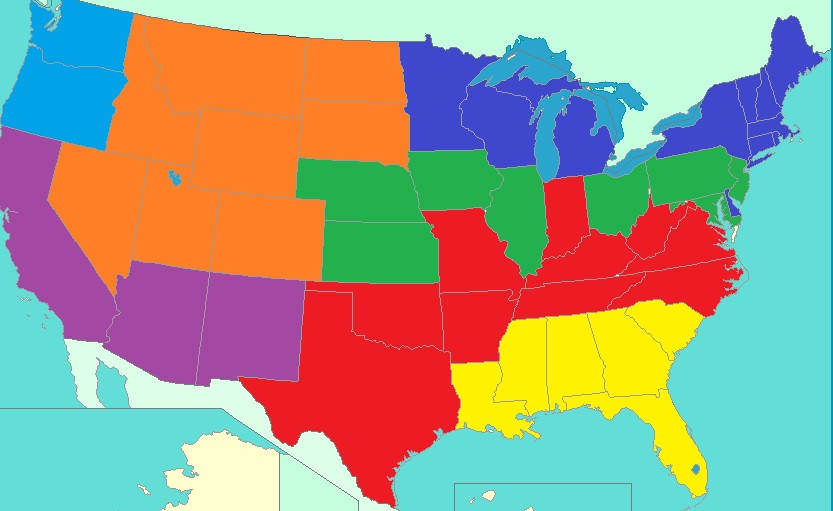
Much is made out of birthrates in America by liberals, conservatives, and those of the dissident right alike. The liberal’s perspective is usually some variation of “whites are dying out, not having enough children to replace themselves and will soon be a minority. We can’t wait!” Amongst conservatives it is an attitude of “at least we’re not as bad as Europe,” and it’s the reason we need to import people south of the border with “family values, who will support the baby boomers in their old age.” I wanted to do a little digging to find out what the state of American birthrates actually was. They are easy enough to find on Wikipedia, but are broken down only by state, rather than state and race. Using the Kaiser Family Foundation and the CDC for raw data, where they break down total population by race as well as births, I was able to calculate birthrates by state for whites only.
For a sense of what crude birthrate (CBR) numbers translate into in the real world, here are some countries well-known for their fertility. Statistics as of 2014:
- Japan: 8.07
- Germany: 8.42
- Poland: 9.77
- Norway: 12.09
- Iceland: 13.09
- All Races of the United States: 13.42
- Ireland: 15.18
- World Average: 19.40
- India: 19.89
- Afghanistan: 38.84
- Niger: 46.12
The birthrates in places like Japan and Germany are so low that the people are on track to nearly halve themselves every generation. India, on the other hand, is growing steadily, while places like Afghanistan and Niger, along with rest of sub-Saharan Africa, have such high birthrates that they have been doubling each generation and will continue to do so…as long as the foreign aid spigot is able to stay on from the West. We can see that America is below replacing itself, even when including the total population of all races.
To further explain, and so that you understand the upcoming numbers, CBR measures the number of children born per 1000 of a selected population in a year. CBR’s relationship with a nation’s demographic health is also measured by a number of other factors, such as the age of the population and the death rate, which measures the number of deaths per 1000 of a selected population in a year. When you subtract the death rate from the birthrate, you are left with the population growth rate, excluding any immigration or emigration. An aging population, which is what all of Western Civilization has now, also adversely affects CBR, as there is a higher proportion of people beyond childbearing years bringing down the average. As general parameters, a birth rate of 10-20 per 1000 people is considered low, which all American regions fall into, while a high CBR is 40-50. As recently as 1960 the CBR for the entire United States was 23.7 children per 1000 people.
How does today’s White America stack up, though, and what kind of differences are there among the various regions and states? Roughly using the borders seen in the recent genetic census of America and the map of cultural regions provided by Colin Woodard in his American Nations, I broke continental America into seven regions along imperfect state borders. Their regional white CBR as of 2015 is as follows:
- El Norte: 9.57
- Yankeedom: 10.00
- Deep South: 10.75
- Midlands: 10.80
- Left Coast: 10.97
- Greater Appalachia: 11.58
- Far West: 12.47

Map of the seven American regions by state borders
In El Norte, which is made up of Arizona, New Mexico, and California, whites are having babies at a lower rate than much of Europe. This region is openly talked about as Mexican land now, and whites do not seem to do well in captivity. Another trend that may not be helping is the number of older white Americans who live in these states as snow birds or retirees, while the younger, more fertile families have moved on to greener pasture north or east of Texas.
Yankeedom is next, with a birthrate higher than Poland, but nevertheless extremely low. This average masks some important differences in the states within Yankeedom, however. States on the east coast, such as Connecticut, have a suicidal white birthrate of 8.13, lower than even Germany, and the lowest in the entire continental United States. Yankeedom’s average is brought up by the states of the Upper Midwest that were historically settled by Puritans, and then followed by culturally similar Scandinavians and Germans. Minnesota has a white CBR of 11.12, the highest in Yankeedom, but they are still falling short of their Scandinavian cousins – which doesn’t say much for American exceptionalism in the birthrate department when looking only at whites. Yankeedom is an important region because it is the third most populous American region by total white population at 39,681,700.
The notoriously conservative Deep South may surprise you, as it consistently measures as one of the most religious regions of the United States. However, it clocked in with the third lowest birthrate by region. This is due in large part to the entire state of Florida being included, as there is no way, with the statistics I have available, to chop off the old, liberal, and homosexual panhandle of the state. Florida has a CBR of 9.46, with the whites of the southern part of the state no doubt being even lower. Other states such as Alabama (11.41), Louisiana (12.71), and Georgia (11.50) have higher white birthrates, although still lower than I expected, and too low to even replace themselves.
The Breadbasket of America, the Midlands, is brought low by the likes of New Jersey (9.39) and Illinois (10.60), home of the white liberal stronghold known as Chicago. The states with the highest white birthrates are Kansas (13.23), and Nebraska (13.11). Other states such as Ohio, Pennsylvania, and Iowa fall somewhere in between. The Midlands, like their politics, are an important barometer of Middle America. They have average birthrates relative to the rest of the American regions and are the second largest American region by white population at 41,313,457.
The Left Coast surprised me, having a higher birthrate than both the Midlands and the Deep South. But since the region is composed of only the states of Washington and Oregon, I think it has everything to do with how different the east and west regions of these states are. Both of them are dominated by liberal coastal cities on the west coast, while the more rural and arid eastern interiors are populated by red state Americans more in the mold of Idaho and Montana. The whites of the cities, I’m sure, have much lower averages than the states as a whole, which bodes well for the Northwest’s future, as long as Portland and Seattle don’t import the world through their harbors first.
Greater Appalachia does not have the largest population when compared with other region, including all races, but it does when only counting whites, coming in at 48,938,996, almost the size of a larger European nation like France. This demonstrates that as with the recent Trump election of 2016, Greater Appalachia will be a bastion of the historical white American identity, and a political force to be reckoned with. There aren’t any extreme outliers in this region, as they all fall along a gradual spectrum. The highest is Oklahoma (13.20), and the lowest is North Carolina (10.91). A great encouragement is Texas, which has some very large and more liberal cities, but as a whole still measures at 11.52. Paired with high amounts of white immigration from other states, Texas won’t turn blue as predicted by the hostile legacy media any time soon. Another fact not reported is that Hispanic birthrates are plummeting in America and Mexico alike as they catch the American Cultural Marxism disease and begin to live more materialistic lives. Trump’s border wall will be a good start, but within a decade the problem will not just be our southern border. More likely, the issue will be if we have been able to close legal immigration from the exploding countries of sub-Saharan Africa and parts of the Middle East.
The most fertile American region is the open, but sparsely populated, Far West. Utah is the most fertile state of this region, with a whopping white CBR at 15.89, beating plucky and historically fertile Ireland, as well as the tropical Bahamas. This is completely due to the large Mormon presence in the state, with a strong religious identity and emphasis on having large families like their Puritan ancestors. North Dakota (13.52) and Idaho (13.05) are the next highest and much less Mormon states, with respectable, but still barely below-replacement, birthrates. Colorado (10.87) and Nevada (10.36) are low outliers that drag the region down, especially Colorado, which has the highest population in the region. With some of the cleanest and wildest land left in the continental United States, it is no surprise that larger families are a norm here. The Far West, however, is small by total population size, with a total white population of only 11,767,600. So the national importance of its high birthrates pales in comparison to the birthrates of other regions.
The differences demonstrated here would be even more drastic if I was able to break down America by “red” Christian tribe vs. “blue” Christian and non-Christian tribe. Even restricted by state borders, we are able to see a clear and large difference. Traditional Christian America would have won the demographic and therefore political battle long ago had not the liberal elites ensconced in power imported voters en masse from all over the globe to swamp and dispossess us in our own land. The most important issue for pre-1965 Americans and their descendants is to close the gates of both legal and illegal immigration so that we and our children can maintain a voice in our own fate and the fate of our government.
| Tweet |
|
|
|




